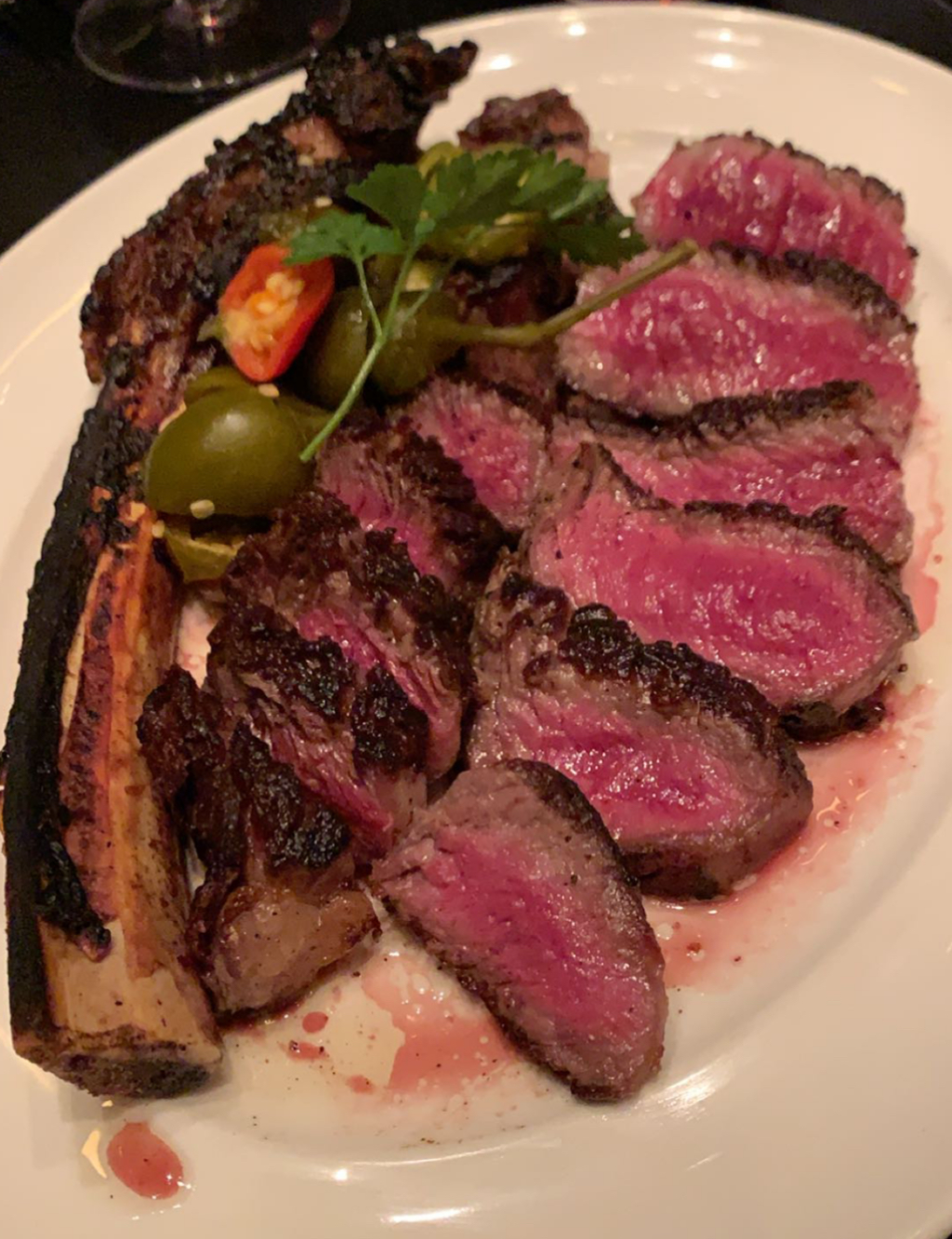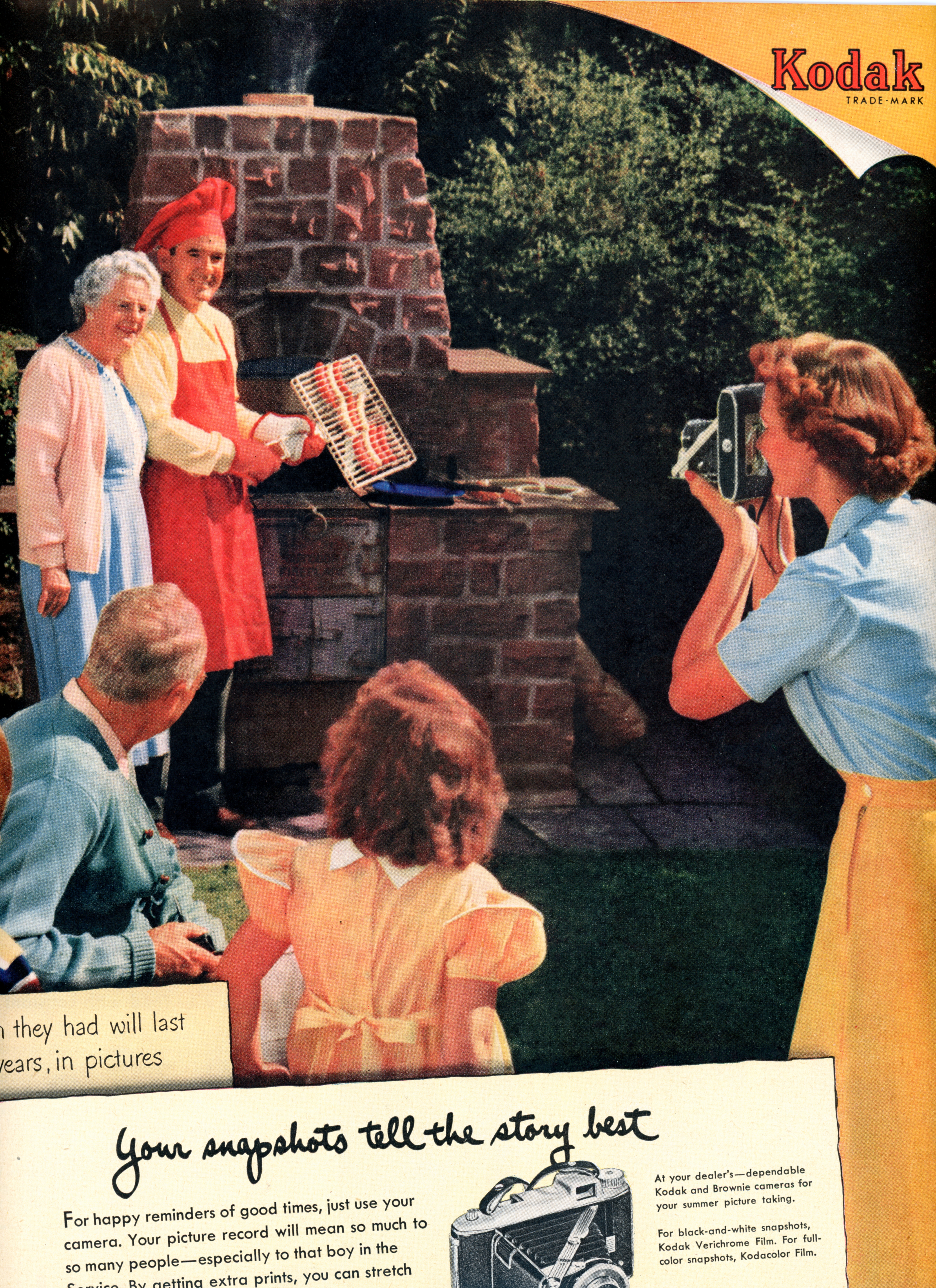While what Danny Meyer has accomplished through Union SquareHospitality Group is laudable, you will always remain partial to Rich Melmanand Lettuce Entertain You Enterprises when discussing the most dominant andinspired restaurateurs in the country. Other groups certainly exist that managea smaller portfolio of superlative restaurants—for example, Boka RestaurantGroup and Hogsalt Hospitality in this very city—yet USHG and LEY receive “extracredit” for the expansive genres of cuisine and styles of dining they excel at.
However, this is all to say that you quite rarely eat at LEYproperties (and you only patronized USHG’s portfolio sparingly when residing inManhattan). Sure, you rushed to places like Aba and Pizzeria Portofino whenthey opened. In fact, you ate at each of them around a half dozen times intheir first couple months of business. Yet, eventually, you exhaust all themenu items and run out of friends to take (who haven’t been), and theseestablishments fade into the background as you return to your usual, moredynamic haunts. And this is meant as no insult to such places, which areexcellent. Rather, LEY excels in its consistency, its ability to take any givendiner who walks through their doors and ensure they will have a most excellentexperience. The staff at their restaurants is uniformly unerring, supremelyunderstanding of the needs of every possibly party and neither pushy norunengaged. Observing one of Lettuce’s properties is like staring at the face ofa finely-tuned clock: the gears that keep everything going are well-hiddenunder the surface, and one can only look in wonder as everything clicks andwhirs in perfect rhythm.
Nonetheless, such precision demands patience. LEY restaurants do addnew dishes, their wine lists are some of the most exciting, rewarding, andever-changing in the city. Yet, like any well-oiled machine, such changes arecarefully made so as not to compromise the whole operation. That is why youtend to forget about Lettuce’s restaurants after those first forays, for theywill be focused on giving as many customers that “golden” first experience withthe well-tuned opening menu. Then, half a year or maybe a year later, an e-mailblast will catch your eye. Or maybe, in a fit of desperation, you make areservation because nothing else is available and you know you’re guaranteed agood time. The menu is replete with new goodies, wondrous creations thatcapture all the excitement of those very first visits. LEY restaurants areguaranteed to grow (in due time), and what they sacrifice in perpetual changethey always make up for with steadfast quality.
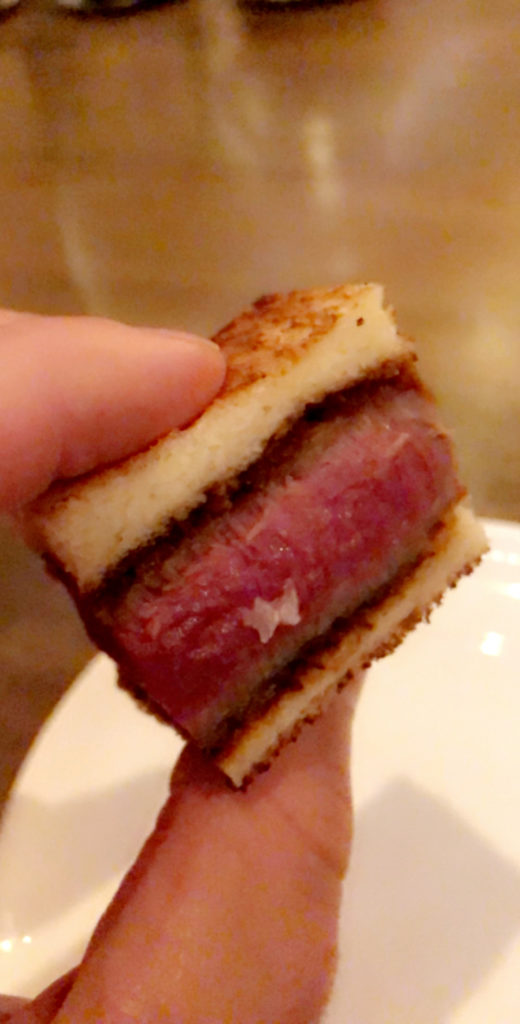
It is upon these ruminations that you returned to RPM Steak for thefirst time in over a year and a half. (Well, you did attend the restaurant’sWagyumafia event in July, but that cannot count as a genuine visit). Readerswill be well-aware of your undying love for Bavette’s, your harsh criticism ofthose steakhouses that choose to purvey foreign beef as their raison d’être.But you enjoy LEY restaurants and enjoy the RPMs quite a bit. They are safeplaces to bring your pickier relatives, standbys in your last minute moments ofneed. You even forget, most of the time, that they were hatched in part as avehicle for a certain celebrity couple. Well, you certainly avoiddrinking the wife’s Prosecco…
You arrive at RPM Steak just a couple minutes ahead of your 5:30 PMreservation with the same crew from Bavette’s in tow. It is the night beforeThanksgiving (a bonafide boozy “holiday” in its own right), and the restaurantis a bit quiet. As you pass your details to the hostess, you spy a gaggle ofguests at the bar and one, no two, parties seated in the dining room. It isearly, you suppose, and even those who plan to drink the night away are surelynot getting started just yet. After just a moment’s pause, your group isescorted into the sepia-toned dining room. It is pretty—with dark, polishedwood offset by white chairs—but plain. Perhaps it could qualify as “sleek,” butnot without the bustle of well-heeled customers to lend it some color. You missthe bric-a-brac that lends Bavette’s its timelessness, the dimmed lighting thatguards other guests from noticing your spying eyes.
The hostess settles on a table near the very center of the diningroom. Its chairs call out to you immediately: two are of the same stark whiteas those at the rest of the tables, while another set of two are in analtogether different tone of dark brown leather. Scanning the other tables, youare unable to find this pattern repeated elsewhere. Some of the chairs havearms; others do not. Yet all of the chairs are white. All of the chairs match.Where did these interloping lounge chairs come from, and why would your partybe led to a table so obviously mismatched? You imagine that one too many of thewhite upholsteries has been ruined and that this brown leather is merely astopgap. You suppose it makes sense for the hostess to put asses in those seatsposthaste, thereby allowing an earlier-arriving party to paper over theinconsistency. Is this just your OCD talking? Your perfectionism? Your firstthought was that they gave your party the “worst seats in the house,” and—evenif there was nothing wrong with the table geographically—the mismatched seatswere a strange detail to be met with.
The other guests seemed not to mind too much, and, surely, you wereall happy to be given armchairs at all. Nonetheless, you felt like a blacksheep. Whatever illusion of perfection that you had thereto ascribed to LEY andthe RPMs had already been shattered. Which is all to say that you would beespecially alert to any other chinks in the proverbial armor. The table is setwith three dinner menus and a four-page book of cocktails and wines by theglass. Tap water is poured by the busser without asking any preference (acalculated move, perhaps, as offering “still, sparkling, or tap” can leavesmore casual diners quite uncomfortable). Not more than a minute or two later,the server arrives. He strikes you as a bit flustered, a bit charmless despitethe white jacket and tie. He has worked at the restaurant for five years, yetpossesses none of the cool, calming effect befitting an establishment that soconsciously exudes a sense of “Classic Chicago.” Not that you adore thesort of show put on by the waiters at Gibsons, but it works to build an overallaesthetic.
The waiter’s opening spiel is interrupted by one of the members ofyour party. His driver is waiting outside, and he wonders if it would be sohard as to get a cheeseburger out to him. “No tomatoes or onions,” is thefurther stipulation, and the server says it will not be a problem. Beforeleaving, he asks if you’d all like a drink. A bourbon, perhaps, you say as youask for the wine list in the same breath. The list arrives and, while you’llneed it later, it lacks any of the spirits. So, another exchange and, at last, thespirits book is in your hands. While you scan it, the driver’s burger arrivesat the table. You admire the speed of the kitchen and are thankful the serveris willing to deliver the order himself. With that task out of the day, youorder three pours of Michter’s 10 Year Old and two Barolos off of the winelist.
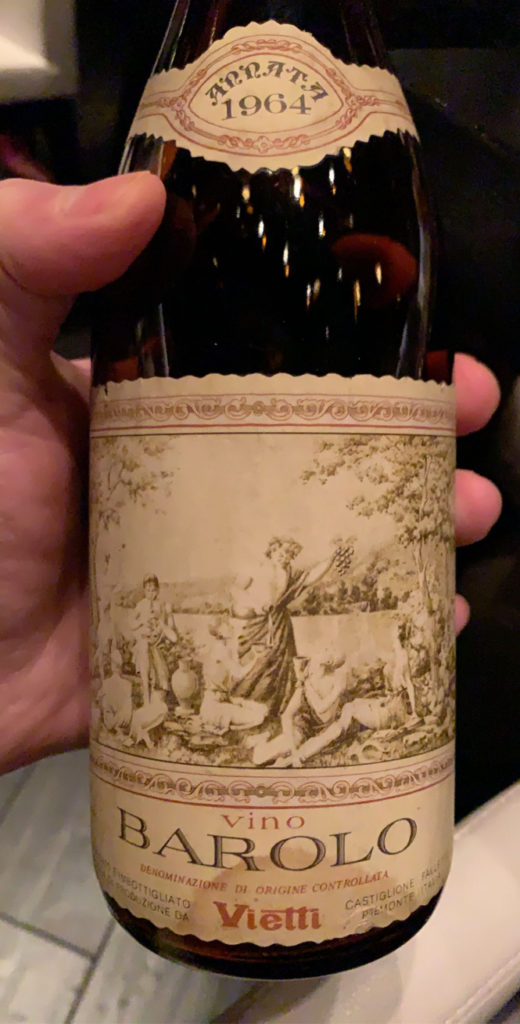
RPM Steak’s wine list, it must be said, is both expansive andattractive. Sure, the usual Cult Cab and First Growth suspects are on offer.Yet mark-ups are not exorbitant, and there are some surprising back-vintagetreasures across regions both big and small. The restaurant’s offerings ofGerman Riesling and the wines of the Loire (both red and white) particularlyimpress you. Given RPM Italian’s presence just a block away, it is no surprisethat some goodies have found their way onto this menu too. By comparison,Gibsons Italia’s list is a bit more pigeonholed—with younger bottles that arenoticeably a bit more expensive. Bavette’s list, which you have lauded before,is only a fraction of the size but more highly curated and provides a bit morevalue. Still, you found it hard to choose from the array of options on offerthat evening. Though you arrived expecting to order a Clos RougeardSaumur-Champigny and a back-vintage Hanzell Pinot Noir, you could not resistItaly. Both bottles of Barolo—from 2004 and 1964—drank incredibly, and,needless to say, you were particularly impressed by the condition and serviceof such an aged wine.
Moving onto the food, RPM Steak’s menu is divided into familiarcategories that seek to outdo the city’s competition by way of sheer quality.Tonight, you snub the hot appetizer section—which includes a bourbon-vanillaglazed thick-cut bacon and a coal-roasted king crab (among its fouroptions)—and move straight to RPM’s “raw” offerings. The trio of bluefin tunaand hamachi crudo catch your eye while the steak tartare—“hand cut” with quailegg and blue cheese toast—doesn’t make the cut. There’s nothing wrong withsteak tartare. In fact, you would yield that steakhouses should reliably offerthe best tartares. But raw beef and cooked beef in two sequentialcourses just seems like overkill. Other than these four appetizers and threeraw dishes, RPM’s menu relies on three kinds of housemade bread, five types of“salad service,” and a classic, crustaceous “cold bar” to round out itsstarters.
Truth be told, it all seems a little “safe,” or at least a littletired. While, visually, RPM Steak spins a contemporary vision of the classicChicago steakhouse, the menu mixes Japanese, French, Latin, and Italianinfluences at will. Why offer a token amount of “sashimi” when the kitchenshould surely be focused on serving $165 seafood platters? Do customers reallystart their meal with beef tataki and hand cut tartare before choosing from aselection of nearly twenty cuts of steak? Of course, you cannot say you orderany of the hot appetizers from your beloved Bavette’s either. Yet theirs fitinto a loose Francophilic theme that, at the very least, offers a cohesivevision. RPM, rather, draws on eclectic influences without ever answering thequestion “why should I order this dish at this restaurant and notat the place that specializes in this sort of food?”
You so thoughtfully sought an answer to that question in ordering thetuna and hamachi dishes. In the same manner, you just had to compare thequality of RPM’s seafood to that at Bavette’s. For one, RPM will be openingtheir “On the Water” property early next year featuring “RPM Seafood,” a“dramatic multi-level restaurant…featuring the truest expression of the world’sbest fish and seafood.” “Truest” expression? Those are fighting words,and you would expect the seafood sourcing at RPM Steak to already be top-notchif LEY thinks it can dedicate a whole restaurant to outdoing everyone else inChicago. It is also worth noting that Bavette’s charges $9 more per half poundof Alaskan king crab (at $39) than RPM Steak (at $30). The restaurants’respective “grand platters” are both priced at $165, so the stage was well-setto work out just which group—Hogsalt or Lettuce—has better mastered the supplychain required to keep the city awash in quality crab.
The waiter, to his credit, takes your opening order of tuna, hamachi, grandseafood platter, and two extra pounds of king crab with aplomb. He offers thatthe grand platter already arrives with a half pound of crab, says he can merelyadd on a pound and a half to make it add up to a full two. You, of course,refuse and welcome all two and a half pounds. By now, the bourbon has arrivedand the first of the two Barolos has been opened, tasted, and decanted. Thesommelier is a poised, confident woman who knows how aged Nebbiolo needs to betreated and shows no hesitation in opening a 55-year-old bottle. She operateswith the kind of knowing reverence you enjoy—no over the top schmoozing orname-dropping to assert her bonafides. Instead, precision and professionalism:the “LEY way.” The sommelier gets you all set up with both decanters and threesets of glasses shortly before the opening salvo of seafood arrives.
The grand seafood platter takes its preeminent position at one cornerof the table. It stands shorter than Bavette’s triple-tiered plateau butfeatures a taller, wider base strewn with oysters, crab, and shrimp around thesides and a medium-sized platter within (which is principally devoted tolobster and any overflow of crab). Each of you also receives a small platterwith cocktail sauce, drawn butter, and a spicy dijonnaise not unlike theaccompaniments provided elsewhere. The brightly-colored tuna and hamachi dishes—bothboasting a half dozen hearty slices of fish—take up positions on the corners ofthe table opposite the platters.
All is set, and so you dig in, reaching first for the bluefin and its“selection of aromatic garnishes.” What those garnishes are, you can’t quitemake out. Truth be told, you cannot quite remember eating this dish other thanfinding the slices of tuna to be appropriately thin and impressively wide. “Serviceable.”Perhaps that’s the world. Not flawed in any way, but not setting the worldalight either. The hamachi crudo was a bit more memorable but still landed verymuch within the realm of a classic, unoffensive preparation. The yellowtail satin a striking marinade of white soy, sesame, and chives that imbued the butteryfish with even more pleasing umami flavor. You do not regret ordering it—nor doyou the tuna—but see these dishes getting lost against the more ample optionsfrom the “cold bar.” Certainly, they would be impressive if they were served afew blocks north at Sushi-San, but, here, they only seem to exist as a nod tocomplement RPM Steak’s selection of Japanese beef (to be discussed furtherlater).
On appearance alone, the RPM Grand Seafood Platter (as it is titled onthe menu) looked to be a worthy rival to Bavette’s Maude’s Tower. For one,there is no salmon tartare to be dealt with (yet there are also no accompanying“everything” crackers, let alone Bavette’s sourdough). RPM’s platter may alsobe shorter, but the bottom layer is far sturdier—the kind of ice bucket thatcould comfortably chill a couple bottles of bubbly. It is placed on a lazySusan that is slipped onto the table around the same time as the cocktailforks, allowing guests to freely grab seafood from any one of 360 degrees. WithRPM’s platter topping out at two levels, there is also no need to disassembleand remove a lower layer midway through the course (though, as mentioned inyour review, it’s a great feat of hospitality accomplished in a confident,unobtrusive way). The seafood itself sure looked good, the king crab possessinga familiar deep red color (from Bavette’s plateau) made all the more strikingby the bright lighting. The shrimp are not the same sort of cocktail shrimp,but “colossal” tiger prawns which dwarf the size of the other crustaceans. Theoysters, also unlike Bavette’s, come already dressed while the lobster isseparated into tails and claws in a similar manner.
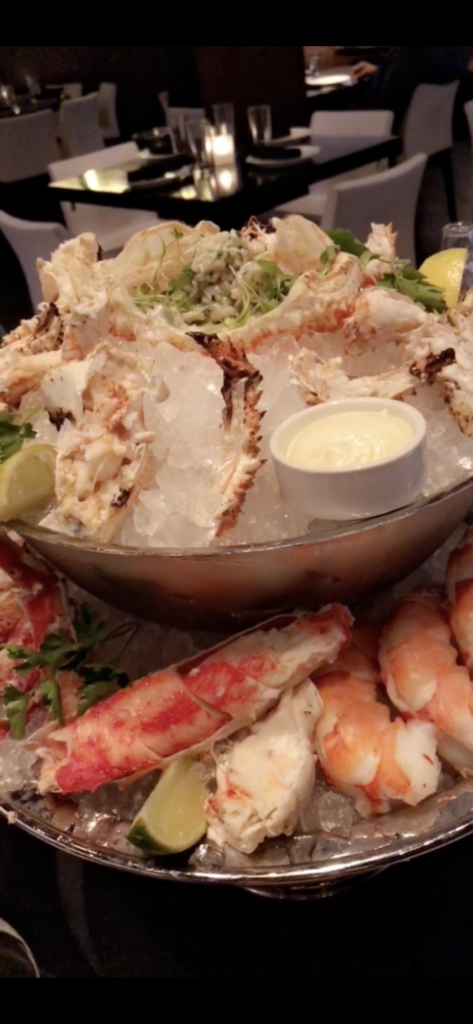
As to how it all tastes? Good, pretty good, but in no waybreathtaking. Those colossal tiger prawns, for one, have only ever appealed tothose whose eyes are bigger than their stomachs. The larger size diluteswhatever natural sweetness cocktail-sized shrimp possess while forcing patronsto chew through larger chunks of unglamorous meat both texturally andflavorfully inferior to the accompanying crab and lobster. A plump cocktailshrimp—even one on the larger size—is a perfect one or two bites with a coatingof cocktail sauce. Just one of RPM Steak’s colossal prawns, on the other hand,nearly exhausts the small ramekin of sauce provided. The restaurant’s decisionto embrace this ingredient can only be called a cynical appeal to the aestheticof “plenty” (or, perhaps, “excess”). They come at a clear sacrifice to taste,and you find the handfuls of more modestly-sized shrimp on Bavette’s tower tobe both more generous and gastronomically pleasing. RPM Seafood would do bestto use their tiger prawns in a cooked preparation should they make their way tothat menu too.
The oysters also left a bit to be desired. Merely termed “chilledoysters” on the menu, you think this evening’s assortment came from the westcoast. A light dressing of jalapeño and cucumber was a welcome addition to thebivalves, but you found most of the shells to be shallow and lacking thenatural brine that gives the best oysters most of their flavor. The meat insidewas cleanly shucked and more or less serviceable, but certain shells struck youas a bit puny. The oyster would reluctantly detach then get lost amongst itsdressing when it hit your tongue. There was little of that plump, seductive,mouth-filling quality for which this delicacy is known. As with the shrimp,Bavette’s bests RPM steak by serving better-sized bivalves from both east andwest coasts. They may not come already dressed at the former, but you take thatas a testament to their implicit flavor and enjoy applying the mignonettefirsthand.
As the results of the seafood tower showdown now stand, it is Bavette’s:2, RPM Steak: 0. But how might LEY’s sourcing fare when it comes to the mostfamous (or famously overrated) crustacean in the sea? Surprisingly, the lobsterwas rather good. You venture to say it is even a better preparation thanBavette’s, where it arrives in a similar manner (split into tail and clawpieces) but remains a blank canvas for the provided sauces and drawn butter.RPM’s “Chilled Lobster Cocktail,” as it is called, features plumper pieces ofmeat that are more tender, more unctuous than almost any chilled lobsterpreparation in the city that you can remember. Seemingly lacking in any sinewor “chew” at all, it almost seems as if the crustacean is lightly dressed withmayonnaise (though you do not believe this to be the case). Rather, you suspectthe lobster is merely of an exceptional quality and perfectly boiled beforebeing chilled down to temperature. This makes sense, given that RPM offers acooked lobster entrée on its menu (more on that later) while Bavette’spreparation is restricted only to its plateaux. But that is by no meansan excuse—RPM Steak deserves credit for its quality here, which also bodes wellfor their forthcoming seafood joint.
So, with RPM poised to snatch a draw from the jaws of defeat, we mustturn towards the most consequential of the seafood platter’s items. King crab,the distinguishing feature of Bavette’s own tower, and comfortably the best tastingcrustacean of them all. Can one really the $9 difference in price between therestaurants? Yes, oh yes, one can. While RPM’s crab certainly looks thepart—boasting that coveted deep red hue—the pieces provided were less thick andultimately less sweet than those at Bavette’s. They were still good, just notgood to the point of adding on those couple extra pounds. Just the same, youwonder if the comparably cut-rate price for crab at RPM Steak is anothermeans—along with the colossal prawns—of the restaurant ensuring more customersindulge in a visually appealing seafood assortment without necessarily aimingto provide the ultimate in quality. With seafood, however, more is not more.Only careful sourcing ensures the natural sweetness of the product, the verysweetness that turns shrimp, crab, and lobster into something more than a merevehicle for sauce and butter.
With the seafood showdown between RPM Steak and Bavette’s now settled,you can turn to the other principle concern one faces when eating in asteakhouse. As previously mentioned, RPM offers some twenty different steaksand chops (compared to just seven at Bavette’s). These run the gamut from fourstyles of Japanese Wagyu, two types of “Imperial” Wagyu (from Omaha), threecuts of filet mignon from Creekstone Farms (in Kansas), two other cuts ofAmerican Wagyu from Beeman Ranch (in Texas), and a selection of steaks dry-agedin house, among others. It’s a dizzying selection that seems to get off onappending as much meaningless information onto proceedings as possible. Theeasiest route seems to be by weight, tailoring one’s order to the desirednumber of ounces and working backwards to select from the available steaks. AtBavette’s, you instantly gravitate towards singular cuts—a bone-in filet and adry-aged ribeye—but how does one choose from no less than five types of ribeyeand four filets?
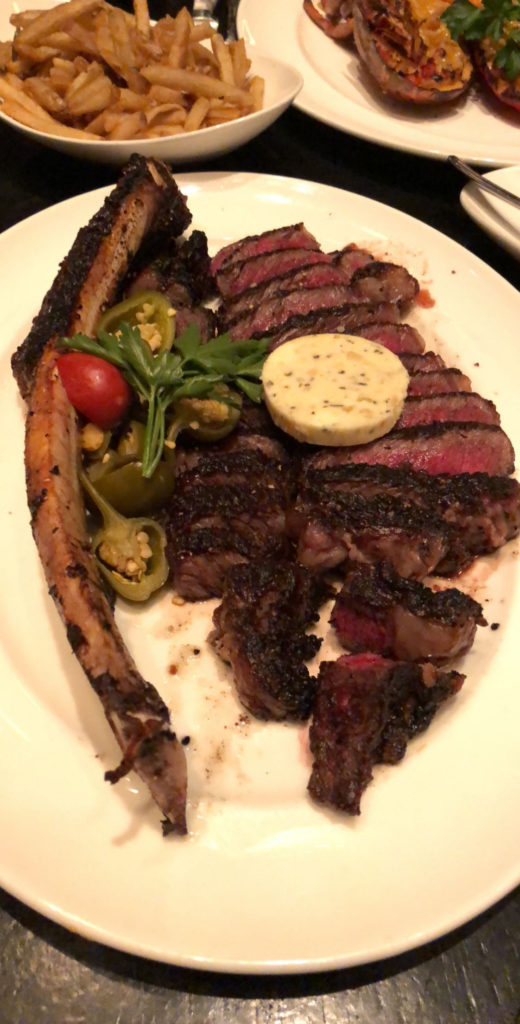
As a matter of principle, you refuse to pay a premium for Japanese beefin an American steakhouse. So, those four items are out. You do not think veryhighly of American wagyu either, particularly the Mishima tomahawk ribeye youhave seen offered around town before and is always, sadly, a disappointment.(Strangely enough, RPM Steak has omitted the “Mishima” text on their updatedmenu and now simply terms it “Tomahawk”). That being said, you have never heardof Beeman Ranch Wagyu before nor their signature Akaushi porterhouse. Akaushi,of course, refers to a particular breed of closed herd red cattle that has beenpurebred in the United States. These cows are prized for the consistency andquality of their meat, though there is less fetishization over “marbling” thanone normally expects when dealing with Wagyu. At 36 oz., the porterhouse wouldcertainly dominate your steak order but also allow you to try both a filet anda N.Y. strip from one of the restaurant’s premiere cuts. So you bit the bullet.As for steak number two? A ribeye of some sort which, excluding that tomahawk,leaves you with four options: a 10 oz. ribeye filet, a 24 oz. cowboy steak, a38 oz. long-bone ribeye (dry-aged for 60 days), and a 20 oz. bone-in ribeyethat is grass-fed in Missouri. Though the grass-fed seems like the naturalchoice (due to its size and nearby sourcing), the other members of your partyare up to tackle the long-bone. That means a total of 74 oz. of RPM Steak’sbest beef will go toe-to-toe with the combined 38 oz. you typically order at Bavette’sin a battle of tenderness, taste, and satisfaction.
For sides? You try to keep things simple: gruyere popovers, creminimushrooms, onion rings, coal-roasted cauliflower, and fries. Oh, and someroasted garlic for the steaks (just like at Bavette’s). The popovers arrived awhile before the main course, as the server astutely noticed you placed theitem before the steaks and all the other sides in the order. Supremely flakeyand ethereally light, the piping hot popovers delighted the table and formed aperfect transition from cold seafood to hot steak. The accompanying prosciuttobutter possessed a mild saltiness and whisper of pork flavor that accentuatedthe natural nuttiness of the gruyere cheese. In all: a great effort (and,perhaps, a good reason to pay for the other two housemade breads offered onRPM’s menu). That being said, one must give Bavette’s some extra credit forserving as many baskets of their sublime sourdough as the guest demands—gratis!
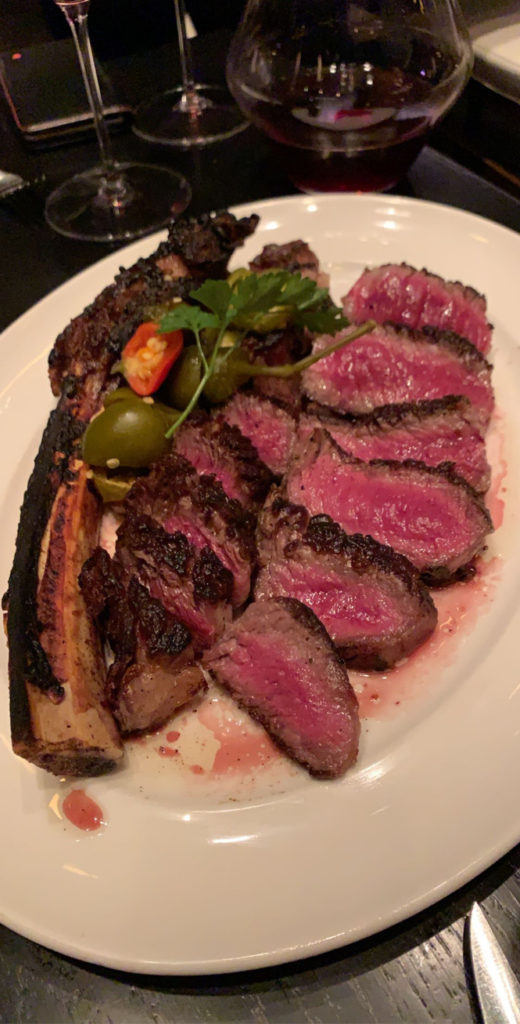
Moving on to the other side dishes (which, of course, arrived lateralongside the two steaks), you largely felt satisfied. The creminimushrooms—one of three types of fungus offered alongside hen of the woods andoyster—came simply sautéed with thyme. It’s an earthier, moresteak-complementary preparation than Bavette’s button mushrooms which, whiledelicious, are doused in sherry cream and coated with crisp onion strings. Twodifferent approaches, surely, and you would probably call it a tie between thetwo dishes. However, RPM deserves some credit for its purist approach andcomparable (both to its rival and to its own other menu items) restraint.Likewise, by merely offering onion rings at all, LEY scores a point onHogsalt’s steakhouse. They arrive at the table unadorned and heaped in a smallbowl. The batter is light and airy—almost tempura-like—and adept at sticking tothe inner strand of onion. You would prefer a crisper, crunchier outer coating(and perhaps a bit more of a discernible onion flavor), yet you cannot complainabout the portion size and would surely order the rings again.
The fries at RPM Steak are actually “rosemary-sea salt” fries whicharrive, like the onion rings, overflowing from a small bowl. The sea salt iscertainly present (in just the right amount for your palate) along with friedstrands of the titular herb. The crispness, again, could be better (are thefryers at the restaurant simply not set high enough?), though the flavor of thepotatoes was more than pleasant without the need for any condiments. Still, youthink Bavette’s has the upper hand due to their fries’ superior texture,slightly higher serving temperature, and an unmistakable savory flavor thatmust come from duck fat. Or, perhaps, they are fried twice in the style ofJimmy’s Red Hots? Regardless, even if one needs to expressly request ketchup,Bavette’s ranks as the winner. Ending on a high note, RPM Steak’s coal-roastedcauliflower was certifiably delicious. Charred on the outside, slightly crunchy(but still moist), the cauliflower arrives cut into small and medium sizedflorets. They sit amongst a lime yogurt sauce on the bottom of the plate whosetang and temperature works well to amp up the vegetable’s mildly sweet, nuttyflavor.
Do the side dishes really matter, though, should RPM’s luxurious cutsof beef completely blow Bavette’s out of the water? Surely, there is somethingspecial about those Akaushi cattle. Undoubtedly, dry-aging a ribeye for aroundtwo months must yield the ultimate expression of umami flavor. But doesit? Unfortunately not. Both steaks arrive looking mouthwatering, having beenskillfully sliced off of their respective bones and assembled in semi-circlesaround their respective platters. The Akaushi porterhouse is cooked to aperfect medium temperature while the dry-aged long-bone ribeye is somewherebetween rare and medium rare (whereas medium was again requested). Both steaksare adorned with a handful of pickled cherry peppers but the side of roastedgarlic is missing. These errors of internal temperature and order transcriptionare amateurish but not irredeemable. Personally, you favor your steak on therarer side, and that garlic could be unneeded should the two cuts offer enoughintensity of flavor.
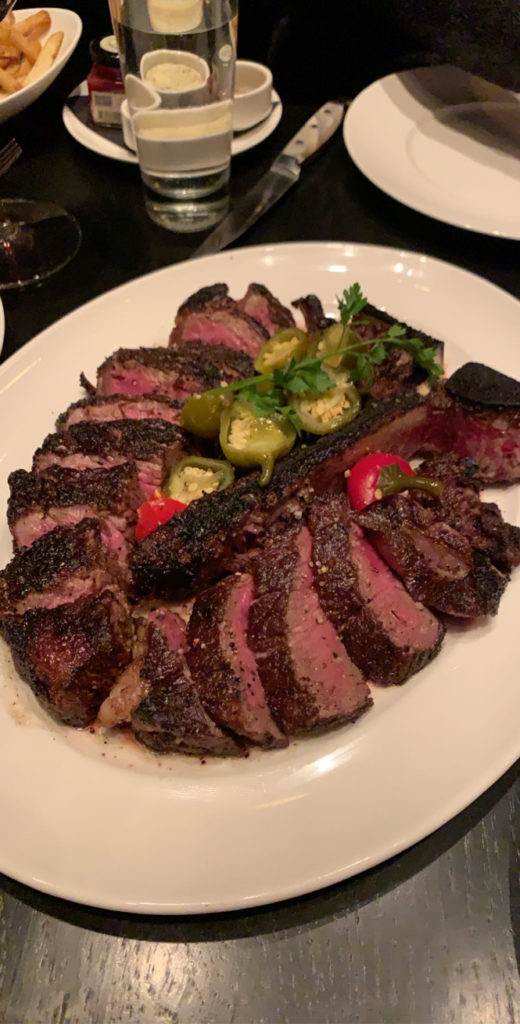
First, you reach for the filet side of the porterhouse. You pick apiece right from the middle of the cut. It is well-charred on the outside andbarely blushing pink within. The filet cuts easily and presents a pleasing chewon the palate—that’s it. Next, your fork treks over to the other side of the T-boneand picks out a piece of the N.Y. strip. It shows a light shade of redindicating that this steak, too, is closer to medium rare than medium. Thestrip cuts cleanly and offers a bit more chew than the filet did. Nothing elseto write home about. The steak’s outer char is the only predominant flavor fromeither side of the Akaushi porterhouse, and the texture, while good, simplydoes not do enough to offset a lack of any distinguishable beef taste.
One would think that sixty days of dry-aging might do the trick andprovide the long-bone ribeye with the deep umami that’s been missing. No luckthere. The ruby red, unabashedly medium rare cut possessed even greater chewthan the N.Y. strip but, again, yielded little by way of flavor. The meat isjuicy. It is free from sinews of pockets of unrendered fat. It all goes downeasy, but it is forgettable. At many times the price of Bavette’s humble cuts,these premium steaks just are not breathtaking. They do not melt in your mouthlike the Bavette’s bone-in filet (a steak cut thicker than either of the twobefore you tonight), and they lack the balance of dry-aging, char, and naturalbeef flavor found in Bavette’s more modest 28-day dry-aged bone-in ribeye. Youfound yourself putting RPM’s steak salt on every piece of meat you ate inbetween munching on the cherry peppers and even stealing sauces off of the sidedishes. Anything to impart some flavor to the steaks!
Does it seem like you are being cruel? You do not think so. Mostpeople will leave RPM Steak feeling relatively happy about the cut of meat theyordered. But they’re not “destination” steaks. They’re not reinventing thewheel. They’re pumping out a pleasant product with enough accuracy and pacingto please the unwashed masses that walk through their revolving doors. Theyplay up the totality of the experience to please everyone rather thantruly excel in offering a focused experience. And there’s nothing wrong withthat. It’s a niche that Bavette’s will never fill by nature of being full everynight. RPM Steak, in its own laudable way, is the standby, the steady, theestablishment that you can always get to and have a pretty good meal thatcaptures the essence of a “Chicago steakhouse.” And for people who have neverhad “real deal” Japanese beef? You can splurge on that too.
Returning to that meal on the eve of Thanksgiving, you would be remissnot to mention a few more food items. Building on the quality of the chilledlobster cocktail that appeared as part of RPM’s grand seafood platter, anentrée of spicy miso Maine lobster (available in half or whole sizes) wasremarkable. You would even say, unabashedly, that RPM Steak prepares lobsterbetter than any other steakhouse in the city. The crustacean was appropriatelysized (if you see one that’s “too” big, you can expect it to be bland) andaccessibly served on the half shell. Its meat—again separated into claw andtail portions—was perfectly plump, free of any sinews, and melted in one’smouth in a manner that is stereotypical of lobster (but that the vast majorityof lobster preparations never attain!). The miso did not make the dishparticularly spicy (though you’re certainly not against warning customers notto expect something simply steamed). Rather the sauce worked well to accentuatethe lobster’s sweetness and pull the dish into deeper, richer territory thatcould satisfy someone who ordered the dish as a lone entrée. Well done!
While you think the dessert at Bavette’s will surely please guests,the two pies and one cake offered there barely merited a mention in yourarticle. RPM Steak, in contrast, can boast an impressive array of eleven differentdesserts that cover every base imaginable. There are two “over-the-top” sundaeswith ice cream made from Kilgus Farmstead milk, a chocolate cake, cheesecake,warm vanilla sugar doughnuts, an apple pie, a coconut carrot cake, soufflé,crème brûlée, and even a tableside Baked Alaska (which seems trendier than everafter you saw Eleven Madison Park reviving it years ago). Though youunabashedly prefer savory food, diners are truly spoilt for choice with thiskind of dessert menu. There are easily five or six items you would insist ontrying had you the stomach for them. Tonight, instead, you opt for the “14K”chocolate cake and the Baked Alaska while the other guests enjoy servings ofvanilla ice cream with hot fudge. The chocolate cake, it should be said, issomething of an RPM Steak signature. It arrives as a horizontal, dark brownsliver about two layers high bedecked with strands of “14K” edible gold.
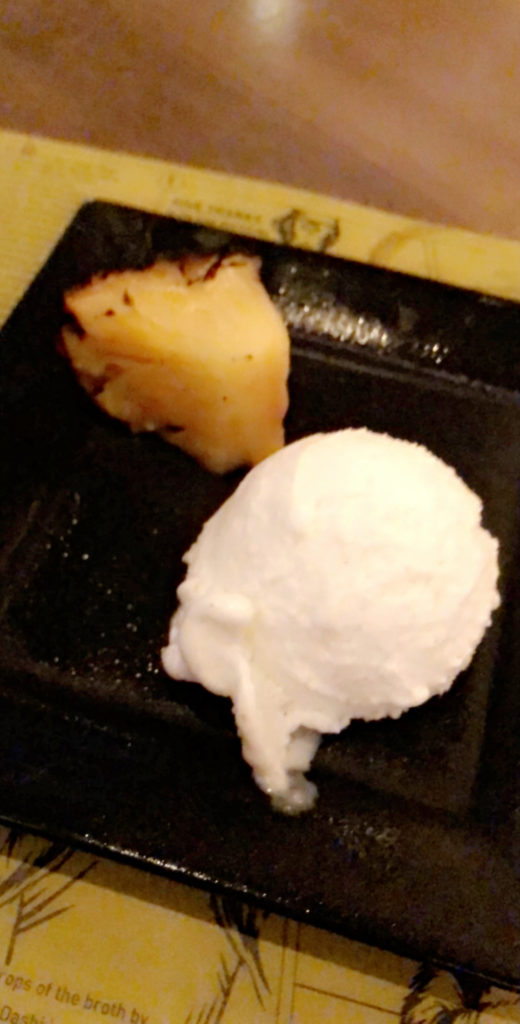
Does it get much tackier? No, but it is hard to imagine a moredecadent (but properly balanced!) chocolate cake, thanks to an artfulcombination of milk and dark chocolate. The Baked Alaska, of course, wasflambéed tableside, making for a nice show. The torched meringue and warmchocolate sauce formed a pleasing combination, but you found the ice cream cakeportion underneath to be a bit too “frozen” and hard to get through with aspoon. Other dessert lovers, perhaps, would have persisted, but the stiff cakewas quickly ignored in favor of the outer layer of cream. The dessert selectionis certainly as crowd-pleasing as the rest of the menu, yet breadth andexecution of the assorted options rises head and shoulders above the rest ofthe city.
In the final analysis, RPM Steak cannot claim to offer better seafoodthan Bavette’s. It cannot claim to offer better cuts of beef or more exactingcook temperatures. The service at RPM, too, is more stilted and, even then,they will miss some of the finer details of your order. That being said, RPM’swine list is wonderful and filled with both fantastic values and rarities. Thelobster—both chilled and cooked—is of “best in the city” quality. The sidedishes (as well as the bread service, salads, fish, burger, and other fillerthat you did not try on this occasion) are sure to please. And, if that doesn’tdo it, then dessert surely will. You think this all adds up to a pretty goodrestaurant. Not a restaurant that is hyper focused on being the “best”steakhouse, but one than can more or less guarantee a good special occasiondinner that inflates the bill a bit but does not leave a bad taste in anybody’smouth. What the LEY formula sacrifices in terms of intimacy it must surely makeup for in terms of pacing, quality, and (relative) value. Otherwise, the gambitjust doesn’t make sense.
RPM Steak caters to the 99% of customers who did not make a Bavette’sreservation a month in advance of their special dinner. The restaurant catersto the 99% of customers who are impressed with hulking cuts of meat from unknownranches, customers who take a bite, find they can chew through it, and think:“fair enough!” Who knows, upon considering the expense accounts, anniversaries,and other celebrations occurring during a given evening, who actually eats atRPM Steak out of a deep love of the food itself? The food itself, not thefeeling of glitz, glam, and an unfussy “steakhouse experience.” Can arestaurant really survive running a revolving door of special occasion dinersrather than cultivating a cadre of regulars? Perhaps it not only can, butLettuce Entertain You has mastered the creation and maintenance of suchconcepts.
Anyone, at any time, can consistently have a very enjoyable meal at RPM Steak. They will feel the staff and the kitchen has done a darned good job of showing them a good time. Yet the experience is still noticeably transactional. There’s no “magic” in the air. No stirring of the soul. RPM is a whirring machine that never stops. They’re aces at impressing those 99% of customers, and, on a given night, they might even impress you. You, the reader, that is. You, the author, is content to keep RPM Steak on the back burner. The back-up option, that is. In the meantime, you will sit comfortably in your corner booth at Bavette’s and wait for RPM Seafood to open its doors. Then, you will eagerly rush over, and the whole LEY restaurant life cycle will begin anew.


